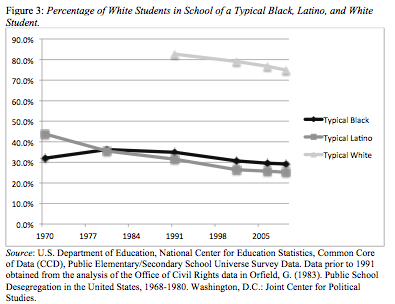- Facebook22
- Total 22
The graph below comes from Gary Orfield, John Kucsera, and Genevieve Siegel-Hawley, E Pluribus…Separation: Deepening Double Segregation for More Students. It shows that African American and Latino students attend schools with decreasing numbers of White students. The trend by itself could be a natural result of growing diversity in the youth population as a whole. In 1970, 79.1% of all public school students were White; in 2009, that was down to 53.7%. If a lower proportion of all students are White, then White, Black, and Latino students will (as a mathematical inevitability) attend schools with fewer Whites–see the graph. But the graph also displays something else: a large gap between the White students’ line and the other two. Basically, White students still attend overwhelmingly White schools even though they represent just over half of the nation’s public school kids.
Orfield et al. make a strong case that persistent (and even rising) racial segregation is bad for students of color:
Schools of concentrated poverty and segregated minority schools are strongly related to an array of factors that limit educational opportunities and outcomes. These include less experienced and less qualified teachers, high levels of teacher turnover, less successful peer groups and inadequate facilities and learning materials.
This is important, but I’d like to suggest an additional perspective. Leaving aside questions of inequality for a moment, we can simply define racial segregation as attending schools without people of a different race. That is true today for some students of color. Fifteen percent of Blacks and 14% of Latinos attend schools that have 99%-100% minority enrollments (although, in some cases, the minorities may come from very diverse racial, cultural, and national backgrounds). But what group is more likely to be isolated? By a large margin, the answer is White students. Only 15.2% of them attend multiracial schools (those with at least a tenth of their students coming from at least three groups), as compared to 27.1% of Black students, 26.2% of Latino students, and 42.1% of Asian students.
I am moved to write this because I just heard the British sociologist John Holmwood make an important point about his country. People of color in the UK are socially, culturally, and economically integrated with individuals from diverse overseas backgrounds and also with White citizens who are working-class or middle-class and who live in metro areas. Two groups in the UK remain segregated: some rural Whites and very wealthy White people. The latter are the ones who are most likely to decry segregation and the supposed failure of multiculturalism. But they are the ones who are segregated.
